| Bus fares | Single fare | Daily cap | Weekly cap |
|---|---|---|---|
| All zones | £1.75 | £5.25 | £24.70 |
| Train fares | Single fare | Daily cap | Weekly cap | ||
|---|---|---|---|---|---|
| Peak | Off-peak | Peak | Off-peak | ||
| Zone 1 fare | £2.90 | £2.80 | £8.90 | £8.90 | £44.70 |
| Zone 1-2 fare | £3.50 | £2.90 | £8.90 | £8.90 | £44.70 |
| Zone 1-3 fare | £3.80 | £3.10 | £10.50 | £10.50 | £52.50 |
| Zone 1-4 fare | £4.60 | £3.40 | £12.80 | £12.80 | £64.20 |
| Zone 1-5 fare | £5.20 | £3.60 | £15.30 | £15.30 | £76.40 |
| Zone 1-6 fare | £5.80* | £3.80* | £16.30 | £16.30 | £81.60 |
| Zone 1-7 fare | £6.70 | £4.90 | £17.80 | £16.30 | £88.90 |
| Zone 1-8 fare | £8.20 | £4.90 | £21 | £16.30 | £104.90 |
| Zone 1-9 fare | £8.30 | £5 | £23.30 | £16.30 | £116.40 |
| Zone 2 fare | £2.10 | £2 | £8.90 | £8.90 | £33.50 |
| Zone 2-3 fare | £2.30 | £2.10 | £10.50 | £10.50 | £33.50 |
| Zone 2-4 fare | £3 | £2.20 | £12.80 | £12.80 | £37.10 |
| Zone 2-5 fare | £3.20 | £2.30 | £15.30 | £15.30 | £44.50 |
| Zone 2-6 fare | £3.60 | £2.40 | £16.30 | £16.30 | £55.90 |
| Zone 2-7 fare | £4.90 | £3.50 | £17.80 | £16.30 | £57.90 |
| Zone 2-8 fare | £5.60 | £3.60 | £21 | £16.30 | £78.90 |
| Zone 2-9 fare | £8.30 | £5 | £23.30 | £16.30 | £78.90 |
| Zone 3 fare | £2.10 | £2 | £10.50 | £10.50 | £33.50 |
| Zone 3-4 fare | £2.30 | £2.10 | £12.80 | £12.80 | £33.50 |
| Zone 3-5 fare | £3 | £2.20 | £15.30 | £15.30 | £37.10 |
| Zone 3-6 fare | £3.20 | £2.30 | £16.30 | £16.30 | £44.50 |
| Zone 3-7 fare | £4 | £2.30 | £17.80 | £16.30 | £57.90 |
| Zone 3-8 fare | £4.80 | £2.30 | £21 | £16.30 | £78.90 |
| Zone 3-9 fare | £8.30 | £5 | £23.30 | £16.30 | £78.90 |
| Zone 4 fare | £2.10 | £2 | £12.80 | £12.80 | £33.50 |
| Zone 4-5 fare | £2.30 | £2.10 | £15.30 | £15.30 | £33.50 |
| Zone 4-6 fare | £3 | £2.20 | £16.30 | £16.30 | £37.10 |
| Zone 4-7 fare | £3.20 | £2.30 | £17.80 | £16.30 | £41.90 |
| Zone 4-8 fare | £4 | £2.30 | £21 | £16.30 | £70.70 |
| Zone 4-9 fare | £4.10 | £2.30 | £23.30 | £16.30 | £70.70 |
| Zone 5 fare | £2.10 | £2 | £15.30 | £15.30 | £33.50 |
| Zone 5-6 fare | £2.30 | £2.10 | £16.30 | £16.30 | £33.50 |
| Zone 5-7 fare | £2.90 | £2.30 | £17.80 | £16.30 | £41.90 |
| Zone 5-8 fare | £3.20 | £2.30 | £21 | £16.30 | £70.70 |
| Zone 5-9 fare | £3.50 | £2.30 | £23.30 | £16.30 | £70.70 |
| Zone 6 fare | £2.10 | £2 | £16.30 | £16.30 | £33.50 |
| Zone 6-7 fare | £2.20 | £2 | £17.80 | £16.30 | £41.90 |
| Zone 6-8 fare | £2.90 | £2.20 | £21 | £16.30 | £70.70 |
| Zone 6-9 fare | £3 | £2.30 | £23.30 | £16.30 | £70.70 |
| Zone 7 fare | £2 | £1.90 | £17.80 | £16.30 | £41.90 |
| Zone 7-8 fare | £2.20 | £2 | £21 | £16.30 | £70.70 |
| Zone 7-9 fare | £2.30 | £2.10 | £23.30 | £16.30 | £70.70 |
| Zone 8 fare | £2 | £1.90 | £21 | £16.30 | £70.70 |
| Zone 8-9 fare | £2.20 | £2 | £23.30 | £16.30 | £70.70 |
| * Journeys between zone 1 and Heathrow are always charged at peak rate on the tube, and £12.80 on the Elizabeth line Note: Oyster card prices are correct as of | |||||
Oyster Card charges for children
| Bus fares | Single fare | Daily cap |
|---|---|---|
| Children aged under-11 | ||
| All zones | free | |
| Children aged 11-15 with an 11-15 Zip Oyster photocard | ||
| All zones | free | |
| Children aged 11-15 with a Young Visitor Discount applied to their Oyster card | ||
| All zones | Half the adult fare | |
| Children aged 16-17 with a 16+ Zip Oyster photocard, and you live in London | ||
| All zones | free | |
| Children aged 16-17 with a 16+ Zip Oyster photocard, and you live outside London | ||
| All zones | £0.85 | £2.55 |
| Train fares | Single fare | Daily cap | ||
|---|---|---|---|---|
| Peak | Off-peak | Peak | Off-peak | |
| Children aged under-11 | ||||
| All zones | free | |||
| Children aged 11-15 with a Young Visitor Discount applied to their Oyster card | ||||
| All zones | Half the adult fare | |||
| Children aged 11-15 with an 11-15 Zip Oyster photocard | ||||
| Zone 1 fare | £1 | £0.90 | £4.45 | £1.90 |
| Zone 1-2 fare | £1 | £0.90 | £4.45 | £1.90 |
| Zone 1-3 fare | £1 | £0.90 | £5.25 | £1.90 |
| Zone 1-4 fare | £1 | £0.90 | £6.40 | £1.90 |
| Zone 1-5 fare | £1 | £0.90 | £7.65 | £1.90 |
| Zone 1-6 fare | £1* | £0.90* | £8.15 | £1.90 |
| Zone 1-7 fare | £1.40 | £1.40 | £8.90 | £1.90 |
| Zone 1-8 fare | £1.90 | £1.40 | £10.50 | £1.90 |
| Zone 1-9 fare | £1.90 | £1.40 | £11.65 | £1.90 |
| Zone 2 fare | £1 | £0.90 | £4.45 | £1.90 |
| Zone 2-3 fare | £1 | £0.90 | £5.25 | £1.90 |
| Zone 2-4 fare | £1 | £0.90 | £6.40 | £1.90 |
| Zone 2-5 fare | £1 | £0.90 | £7.65 | £1.90 |
| Zone 2-6 fare | £1 | £0.90 | £8.15 | £1.90 |
| Zone 2-7 fare | £1 | £0.90 | £8.90 | £1.90 |
| Zone 2-8 fare | £1.40 | £1.40 | £10.50 | £1.90 |
| Zone 2-9 fare | £1.40 | £4.30 | £11.65 | £1.90 |
| Zone 3 fare | £1 | £0.90 | £5.25 | £1.90 |
| Zone 3-4 fare | £1 | £0.90 | £6.40 | £1.90 |
| Zone 3-5 fare | £1 | £0.90 | £7.65 | £1.90 |
| Zone 3-6 fare | £1 | £0.90 | £8.15 | £1.90 |
| Zone 3-7 fare | £1 | £0.90 | £8.90 | £1.90 |
| Zone 3-8 fare | £1 | £0.90 | £10.50 | £1.90 |
| Zone 3-9 fare | £1 | £0.90 | £11.65 | £1.90 |
| Zone 4 fare | £1 | £0.90 | £6.40 | £1.90 |
| Zone 4-5 fare | £1 | £0.90 | £7.65 | £1.90 |
| Zone 4-6 fare | £1 | £0.90 | £8.15 | £1.90 |
| Zone 4-7 fare | £1 | £0.90 | £8.90 | £1.90 |
| Zone 4-8 fare | £1 | £0.90 | £10.50 | £1.90 |
| Zone 4-9 fare | £1 | £0.90 | £11.65 | £1.90 |
| Zone 5 fare | £1 | £0.90 | £7.65 | £1.90 |
| Zone 5-6 fare | £1 | £0.90 | £8.15 | £1.90 |
| Zone 5-7 fare | £1 | £0.90 | £8.90 | £1.90 |
| Zone 5-8 fare | £1 | £0.90 | £10.50 | £1.90 |
| Zone 5-9 fare | £1 | £0.90 | £11.65 | £1.90 |
| Zone 6 fare | £1 | £0.90 | £8.15 | £1.90 |
| Zone 6-7 fare | £1 | £0.90 | £8.90 | £1.90 |
| Zone 6-8 fare | £1 | £0.90 | £10.50 | £1.90 |
| Zone 6-9 fare | £1 | £0.90 | £11.65 | £1.90 |
| Zone 7 fare | £1 | £0.90 | £8.90 | £1.90 |
| Zone 7-8 fare | £1 | £0.90 | £10.50 | £1.90 |
| Zone 7-9 fare | £1 | £0.90 | £11.65 | £1.90 |
| Zone 8 fare | £1 | £0.90 | £10.50 | £1.90 |
| Zone 8-9 fare | £1 | £0.90 | £11.65 | £1.90 |
| Children aged 16-17 with a 16+ Zip Oyster photocard | ||||
| All zones | Half the adult fare | |||
| Children aged 11-17 without any kind of discount or photocard | ||||
| All zones | Same as the adult fare | |||
| * Tube journeys between zone 1 and Heathrow are always charged at the peak rate. Elizabeth line journeys between zone 1 and Heathrow are £10.20 during off-peak hours and £12.80 during peak hours Note: Oyster card fares are correct as of | ||||
What is an Oyster card?
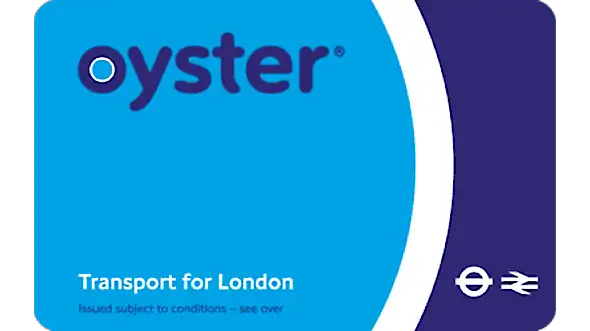
An Oyster card is a credit card-sized piece of plastic. Other countries might call them a metro pass or travel smartcard. They come in four different types:
Oyster pay-as-you-go – The idea behind a pay-as-you-go card (or PAYG) is that you load it up with credit and the computer will deduct the correct fare every time you touch it against a reader. If you start running low on credit then you can simply top it up at a ticket machine. PAYG Oyster cards do not have expiry dates on, and your credit remains valid forever.
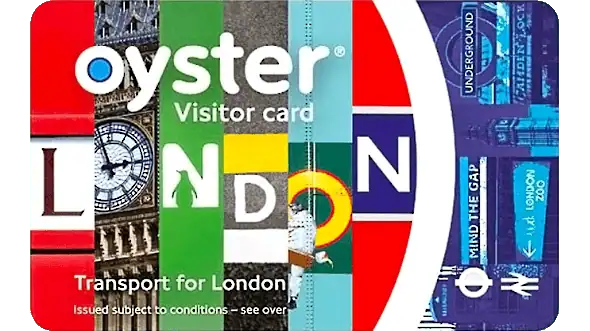
Visitor Oyster card – A Visitor Oyster Card is exactly the same as a normal pay-as-you-go card, but comes with a couple of extras that are primarily aimed at tourists. The most obvious difference is that it comes pre-loaded with credit to save you the hassle of having to load it on yourself. Check out our Visitor Oyster Card page for a full comparison of Visitor Oyster cards vs regular Oyster cards.
Oyster travelcard – Oyster travelcards work differently to pay-as-you-go cards because you don’t have to keep topping them up with credit. You simply choose your start date, and the zones you want it to cover, pay a one-off fee, and then you can make an unlimited number of journeys until it expires. Visit our London travelcard page for more details. [Note: it’s not possible to load a 1-day travelcard for the Train, Bus & Tram onto an Oyster card, and you can’t load any travelcards at all onto a Visitor Oyster card or contactless card, only the normal blue Oyster cards.]
Oyster travelcard + pay-as-you-go – It’s also possible to load some pay-as-you-credit straight onto an Oyster travelcard – but only the weekly and monthly ones.
This can actually be quite handy. Imagine that you’re travelling around zones 1-2 for a week, but you need to make a single journey into zone 6 for Heathrow airport. Buying a zone 1-6 weekly travelcard would be a waste of money just for a single trip, so you’re better off buying a travelcard for zones 1-2 and then loading on some extra pay-as-you-go credit on to cover it. The computer will recognise that your travelcard already covers zones 1-2 and deduct the difference from your credit.
What are the benefits of an Oyster card?
- Oyster is accepted all across the transport network: on the bus, London Underground, London Overground, DLR, TFL Rail, National Rail, Thames Clipper riverbus, and even the IFS Cloud Cable Car
- Oyster card prices for a single bus and tube journeys are always the lowest available (along with contactless), and the Oyster daily cap is always cheaper than buying a 1-day travelcard
- The Oyster daily cap means you can make an unlimited number of journeys without going above a set price
- Oyster pay-as-you-go credit can be used from zones 1 to 9, whereas travelcards are only valid in the zones you buy them for
- Oyster pay-as-you-go credit never expires, so if you have any left over at the end of your holiday you can use it on your next visit
- If you register your Oyster card and lose it then you haven’t lost all of your money – you can just put it onto a replacement card
What is the Oyster daily cap?
Daily price cap – The big advantage in using a pay-as-you-go Oyster card over a TFL travelcard is the Oyster daily cap. Think of it as a price ceiling – it’s the maximum daily charge that the computer will take from your credit per day (it actually runs from 04:30 AM to 04.29 AM the following day). It doesn’t matter how many buses or trains you ride during that period, the max per day will never rise above the daily limit – and Oyster card cap rates are always lower than the cost of 1-day travelcard.
If you want to pay the bus cap (which is the cheapest one) then you’ll have to stick with the buses all day. If you use a mixture of buses and trains (or just the trains on their own) then you’ll have to pay the train cap instead.
Weekly price cap – Oyster users can also benefit from a weekly cap. This caps the price at the same rate as a weekly travelcard. Unfortunately it only runs from Monday to Sunday, and not any other combination of days, so if you’re here from Wednesday to Tuesday, for example, then you’ll just get 7x daily caps instead.
Note: Journeys to Gatwick airport and on the Heathrow Express don’t count towards the TFL daily cap, and journeys on the IFS Cloud Cable Car and Thames Clipper don’t count either. The computer will simply deduct the relevant charge from your credit.
What time is Peak and Off-Peak?
Peak – Peak fares apply to any tube journey that starts between 6:30 AM and 9.30 AM (Monday to Friday), and between 4 PM and 7 PM (Monday to Friday). It doesn’t matter what time your journey finishes.
Off-Peak – Weekends and public holidays are always classed as off-peak.
Where can you buy an Oyster card?
You can buy an Oyster card in four different ways:
From the TFL website – The easiest way is to buy an Oyster card online from the TFL website and have it delivered to you. This website is only suitable for people who live in the UK, though. If you want it delivered abroad then you will have to buy an Oyster card for visitors instead.
UK delivery typically takes between 2-4 days.
From a train station – The second way to get an Oyster smartcard is from a manned ticket window at a train station. TFL have removed all the manned ticket windows from the underground tube stations though, so if you want to speak to a human then you’ll have to visit a big National Rail station instead. (National Rail stations are the big overground hubs like Euston, Liverpool Street, London Bridge, King’s Cross, Marylebone, Paddington and Waterloo.)
From a Travel Information Centre – The third way is to buy one from a Visitor Centre at Euston station, King’s Cross station, Liverpool Street station, Paddington station, Piccadilly Circus station, Victoria station and Heathrow airport (there are actually two at Heathrow: one inside Terminals 2-3, and another one inside the Underground station).
From an Oyster Ticket Stop – You can also buy them from around 4,000 Oyster Ticket Stops all over London. These are basically just high-street shops (usually newsagents), which have a blue Oyster card symbol showing in the window.
Important – you have to pay a deposit of £7 the first time you buy an Oyster card, and you can’t use that money for fares. So if you decide that you want £20 credit then you will have pay a total of £20 + £7.
How do you top-up an Oyster card?
By using the TFL app – The simplest way to top-up an Oyster card is through TFL’s official Oyster and contactless app. Once you’ve bought yourself a card and registered it with TFL you can top it up with your debit card or credit card. You can also use the app to look up your journey history. [Note: You might have to wait for thirty minutes before the money actually appears on your card, which is something to bear that in mind if you’re in a rush!]
Through the TFL website – Similarly, once you’ve registered your Oyster card on the TFL website you can log in and top-up online.
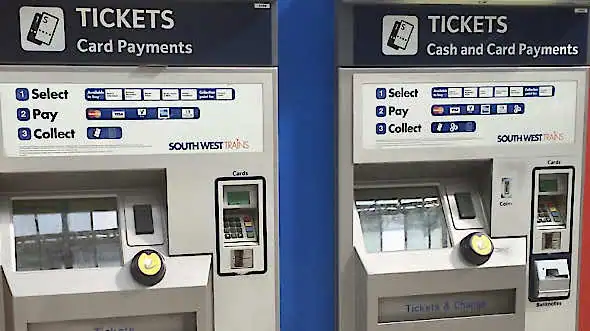
At a train station – Another easy way to top-up is by using one of the self-service ticket machines at a train station. Just tap the card on the big round yellow reader and select top-up on the machine. You can either pay by cash, debit or credit card. Note that some ticket machines are only set up to take credit cards and debit cards, and not cash, so make sure you check the signage before you press any buttons.
At an Oyster Ticket Stop – The fourth of adding some credit to your card is at an ‘Oyster Ticket Stop’. These are basically just high-street shops (usually newsagents), which have a blue Oyster card symbol showing in the window. Just hand them your card and tell them how much credit you want to add on.
Automatic top-up – If you can’t be bothered to keep topping it up yourself then you can also take advantage of the Oyster card’s ‘auto top-up’ feature, which will automatically draw another £10, £20 or £40 from your bank account every time your credit drops below £20. You can set this up at the TFL website.
Note: The minimum amount of money that you can add at an Oyster Ticket Stop is £1.50. The minimum amount that you can add online or at a ticket machine is £5. The maximum amount that the card can hold in total is £90.
How much credit do you need on an Oyster card?
The amount of credit that you need on your Oyster card will depend on how long you’re staying in London for, and where you’re planning to go, but here are some tips for visitors:
Unless you fly in from Heathrow (zone 6), you will probably spend the majority of your holiday inside zone 1 (the touristy bit). You might also visit zone 2 is for places like Camden, Canary Wharf and Greenwich.
Our tube journey planner will tell you which zones you pass through for each station. For example, if you look at the journey from Heathrow airport to Paddington then you’ll see ‘This journey is in zones 1-6’ written in the fares box.
Once you know which zones you’ll be travelling through each day, look up the ‘daily cap’ for those zones on this page. That is the maximum daily charge that the computer will take from your card for that day. If you add up all the daily caps for all the days that you’re staying in London, then the total will be how much credit you need to load onto your Oyster card. Easy!
Bear in mind that you will also have to pay a £7 deposit the first time you buy your Oyster card. And you can’t use that £7 towards fares. So if you decide that you need £20 credit then you will have to pay a total of £27.
How long does an Oyster card last?
The credit on an Oyster card lasts forever. If you don’t use the money up during your first trip then you can carry on using it during your next one.
If you load a travelcard onto an Oyster card then it will have an expiry date. Once you go past the expiry date the travelcard will be useless, but don’t throw away the empty Oyster card because you can always load another travelcard or some pay-as-you-go credit onto it.
How do you get an Oyster refund?
There are two main ways to refund the credit on your Oyster card:
At a train station – You can claim back any unused credit at a self-service ticket machine in one of London’s train stations – but only up up to a maximum of £10. Just touch your Oyster pass against the yellow reader and select ‘Oyster Refund’, and follow the on-screen instructions.
Note: It is not possible to claim back the deposit if your card was bought after 4th September 2022. If your card was bought between the 23rd February 2020 and 3rd September 2022 then you would have paid a deposit of £5 instead, and that money would already have been converted into pay-as-you-go credit on your card, which you can refund in the normal way.
Claiming a refund online – If you need a refund of more than £10 then you will have to visit the TFL website. But this only works if you set up an online account beforehand. And it’s not possible to set up an account for a Visitor Oyster card – only normal Oyster cards.
Keeping the credit – If you can’t be bothered to get a refund then don’t throw the Oyster card away. The credit never expires, so you can carry on using it the next time you’re in town.
What is the Young Visitor Discount?
If your child is aged between 11 and 15 then you can take advantage of the Young Visitor Discount to get cheap child fares. This allows kids to get 50% off the adult Oyster fare for fourteen consecutive days. The discount does not apply to travelcards.
All you have to do is buy your child a normal London Oyster card (not a travelcard), load some pay-as-you-go-credit onto it, and then ask a member of the TFL staff to apply the Young Visitor Discount to it. You can do this at London Underground stations, TFL Rail stations, National Rail stations within London, or at a London Visitor Centre (except the one at Gatwick airport).
Note: Your child must be with you when you do it (up to a maximum of four children per adult), and the member of staff may ask for proof of age.
Your child can then use the card in exactly the same way that they would normally, tapping it down on the yellow Oyster readers on the buses and trains.
Once the fourteen consecutive days are over any credit left on the Oyster card will still be there, but it will revert back to charging adult fares again.
Do seniors get cheap Oyster fares?
There are no senior citizen concessions for foreign visitors, but if you have an OAP bus pass with a red rose symbol on it then you can already travel for free on any bus carrying the TFL symbol:
Unfortunately it doesn’t apply to trains as well, just the buses. If you want to travel on the tube and live in a London borough then you’ll have to apply for a 60+ Oyster card:
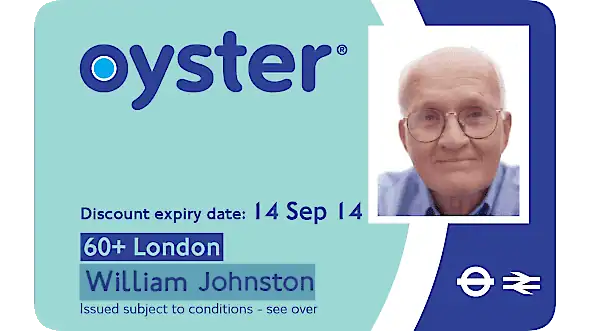
60+ London Oyster photocard – This entitles you to travel for free on London’s buses, trams, London Underground, London Overground, DLR and TFL Rail after 9 AM on weekdays and any time during the weekend. Most National Rail trains within London can be boarded after 9.30 AM on weekdays and any time during the weekend.
In order to get one you have to be living in a London borough and be aged 60 or over. You can apply online at tfl.gov.uk by supplying some ID and proof of address.
Note: As soon as you’re old enough to receive a woman’s state pension (regardless of whether you’re a man or a woman) then you have to switch over to a Freedom Pass which offers similar benefits, but is supplied by your local council instead.
Can you pay two fares with one Oyster card?
No. It is not possible to pay two fares with one Oyster card. Lots of tourists tap them down twice making the perfectly reasonable assumption that it will subtract two fares, but the system doesn’t work like that. The first time you tap down the computer will think that you are entering the station, and the second time you tap down it will think that you are leaving the station.
At this point it all starts to get extremely confusing… if you tap down twice at the same station within 2 minutes then you will be charged for a ‘same station exit’, which is 1x maximum fare (from your station to the end of the line). This will automatically be refunded back onto your card if you begin a new tube journey within 45 minutes.
If you tap down twice at the same station within 2-30 minutes then you will be charged 1x minimum fare (from your station to the next one in the same fare zone). And if you tap down twice at the same station after 30 minutes then you will be charged 2x maximum fares (one for each tap).
Is Oyster the cheapest way to travel in London?
Oyster fares are the cheapest way to travel on London’s buses and trains (alongside contactless). But if you need to buy a brand-new Oyster card then you’ll also have to pay a £7 deposit on top – and you can’t get that money back. So contactless actually works out cheaper for first-timers.
The Oyster card cap is always cheaper than buying a day travelcard (but not if you have to pay the £7 deposit on top).
An Oyster card will also work out cheaper than buying a weekly travelcard, unless you’re planning on making three or more journeys on six days, or two or more journeys on seven days.
Where can you use Oyster in London?
Buses – You can use a London Oyster card on all TFL buses (but not sightseeing buses).
London Underground, London Overground, DLR, TFL Rail, National Rail – You can use Oyster cards on trains within Oyster zones 1-9, plus some stations outside the zones including Watford Junction (for Warner Bros Studios) and Gatwick Airport.
Note: If you use it on the Gatwick and Heathrow Express then the fare won’t count towards the daily cap maximum charge. It will just deduct the fare from your credit.
Look at TFL’s handy map to see which stations are within the Oyster zones: http://content.tfl.gov.uk/london-rail-and-tube-services-map.pdf.
IFS Cloud Cable Car & Thames Clipper – You can pay for a ticket on the cable car and Uber’s Thames Clipper by touching your card down on the gate, in exactly the same way that you do for the buses and trains.
But bear in mind neither of these will count towards the travel cap, it will just deduct the relevant fare from your credit.
How do you use Oyster on a bus?
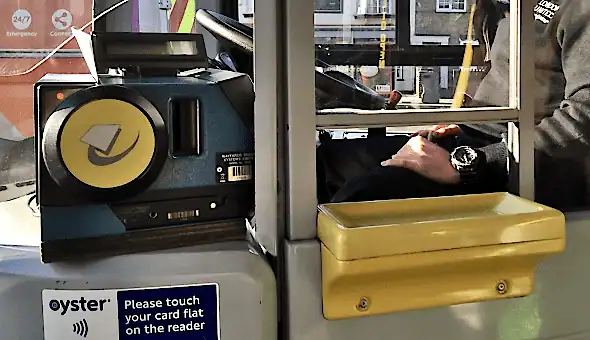
Using an Oyster card on a London bus is easy. All you have to do is touch it against the big round yellow reader inside the front door. Some styles of bus will also have an Oyster reader by the middle door and back door, but if you’re a newbie to London and want to play it safe then always board it by the front door, because every style of bus will have one there.
If the card registered correctly then you should hear a beep and see a little green light on the reader. If it didn’t work then try taking it out of your wallet and holding it flush with the reader.
The computer will automatically deduct the correct fare from your card, and the remaining credit will be shown on a small screen close to the reader – which is a handy way to check the balance on your card.
There is no need to touch down again when you leave the bus – you only have to do that for trains.
How do you use Oyster on a train?
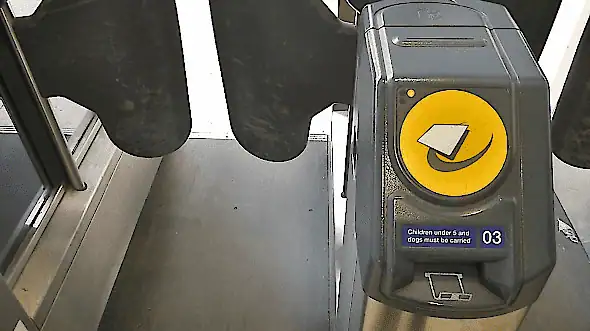
Using an Oyster card on the train is easy. All you have to do is wave your Oyster card in front of the big round yellow reader at the front of the gate, and wait for the green light to appear. If it worked correctly then the correct fare will be deducted from your card and the gate will open automatically.
If the gate refuses to move then try getting your card out of your wallet and touching it flush against the reader. If that doesn’t work then you’re probably out of credit.
Some of the smaller train stations might not have any gates, and you’ll find the Oyster reader on the platform or by the platform stairs instead.
You also need to touch down again at the end of your journey because the computer needs to work out which zones you travelled through. If you forget to touch down then it won’t know where you went, and you’ll be whacked for the maximum fare on that line.
Note: Sometimes the train station staff will open the gates to speed the flow of people through the station at rush hour, but you must STILL tap down. If there’s a busy event on (like a music festival or a football cup final) then you might not be able to, and the computer might try and guess your destination by itself. But you should always try and tap down to be safe, otherwise you might be lumbered with that maximum fare.
What are pink Oyster readers for?
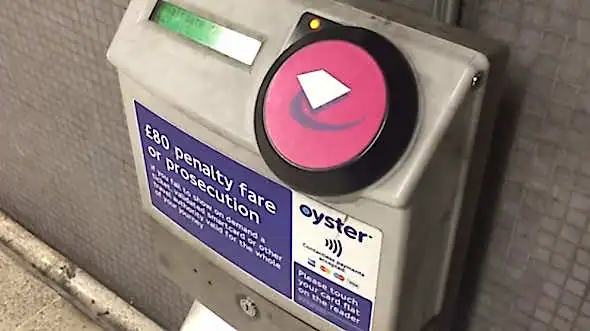
Fifteen stations have pink Oyster readers: Blackhorse Road, Canada Water, Clapham Junction, Gospel Oak, Gunnersbury, Highbury & Islington, Kensington Olympia, Rayners Lane, Richmond, Stratford, Surrey Quays, West Brompton, Whitechapel, Willesden Junction and Wimbledon.
The pink readers are there because some journeys are cheaper if you avoid travelling through zone 1. For example, if you want to travel from Epping (zone 6) to Richmond (zone 4), then you would normally go through zone 1. But if you don’t mind a slightly longer journey then you can change onto the London Overground at Stratford and bypass zone 1 completely.
Unfortunately the computer has no way of knowing you did this because you don’t have to pass through any barriers when changing trains at Stratford – so it will continue to charge you for zones 1-6 regardless. So what you have to do is prove that you got off at Stratford by touching down on the pink reader.
Pink readers can usually be found on the platforms, or at the entrance to the platform stairs.
Which is best: Oyster cards, contactless or travelcards?

If you’re a foreign visitor coming to London for just one day then you’re better off with a day travelcard. The Oyster daily cap might work out cheaper than buying a 1-day travelcard, but when you factor in the extra £7 deposit then it actually works out more expensive.
If you’re a foreign visitor coming to London for more than one day then the Oyster card cost becomes better value… unless you’re planning on making three or more journeys on six days, or two or more journeys on seven days, in which case a weekly travelcard is likely to be cheaper.
We always recommend that UK visitors pay with contactless, regardless of how many days they’re staying. That’s because the fares are exactly the same as Oyster, but you don’t have to pay a deposit to get one.
Note: If you’re a foreign visitor then Oyster is still preferable over contactless, because your bank might add on a transaction fee every time you use it overseas, which will likely apply to each individual ticket.
The verdict: Contactless is the best option for UK visitors. Oyster is the best option for foreign tourists staying more than one day, and a 1-day travelcard is the best option for foreign tourists staying for just one day.
 Twitter
Twitter Facebook
Facebook Bluesky
Bluesky WhatsApp
WhatsApp Email
Email






